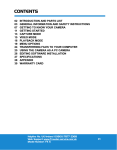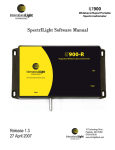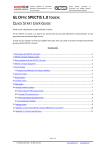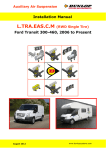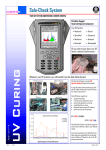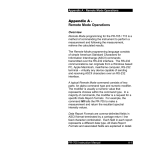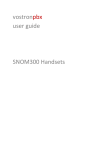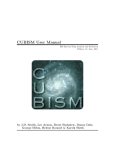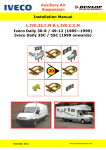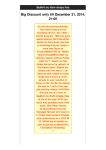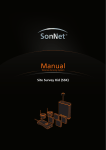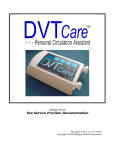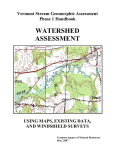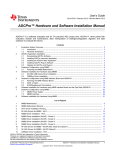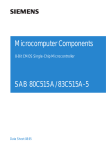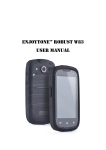Download Sola-Hazard Manual
Transcript
SolaHazard USER MANUAL For assessing the human skin response to UV lamps using UV spectral measurements 8 th Jul 98 : Rev 1.0 file : SolaHazard MAN798 final.doc IMPORTANT The calibration of this equipment is traceable with the National Physical Laboratory (NPL)of the United Kingdom. The optical bench used for this calibration is similar to those used in Physics for calibrating detectors and spectroradiometers. It is not specific for the measurements of solar cabins. The very different geometry used in this application may account for significant differences in the measurements. Therefore, it is recommended to check the conformity of the measurements against an optical bench specifically designed and calibrated for this application. Without such a check and any relevant scaling factor being applied, no claim as to the standardised accuracy of the instrument for the specific application can be made, or is warranted by the manufacturers. 1 (c) 4D Controls Ltd. 1999 09/03/01 SolaHazard USER MANUAL For assessing the human skin response to UV lamps using UV spectral measurements 8 th Jul 98 : Rev 1.0 file : SolaHazard MAN798 final.doc 1. 2. 3. OVERVIEW ................................................................................................... 3 HARDWARE .................................................................................................. 6 TECHNICAL INFORMATION........................................................................ 8 4.1 Switching On ............................................................................................ 11 4.2 Switching Off .................................................................................................. 12 4.3 Menu Control............................................................................................ 12 5. GRAPH MODE.............................................................................................. 16 6. UV SPECTRAL MEASUREMENT - TUNING THE SCAN .............................. 18 6.1. Select the Sample Time .......................................................................... 18 7. STORING THE RESULT ................................................................................ 20 8. ANALYSING THE UV DATA IN GRAPH MODE ........................................ 21 8.1. Tracing along the graph ........................................................................ 21 8.2. Zooming in to have a closer look ......................................................... 21 8.3. Calculated Power or Area Under the Graph ..................................... 21 9. UNDERSTANDING A UV SPECTRUM ........................................................ 22 9.1. Sample Time, Smart Scan and Saturation Explained ........................ 22 10. CONNECTING THE SOLA HAZARD TO A PC VIA SOLATERM ............... 24 11. CONNECTING SOLA HAZARD TO SOLATELL PRINTER........................... 25 12. TROUBLE-SHOOTING................................................................................. 26 13. QUICK REFERENCE.................................................................................... 27 14. SPECIFICATION.......................................................................................... 28 14.1. Sensor......................................................................................................... 28 14.2. Sola Hazard............................................................................................... 29 14.3. A Note on Batteries.................................................................................. 30 2 (c) 4D Controls Ltd. 1999 09/03/01 SolaHazard USER MANUAL For assessing the human skin response to UV lamps using UV spectral measurements 8 th 1. Jul 98 : Rev 1.0 file : SolaHazard MAN798 final.doc OVERVIEW Congratulations! You are now the proud owner of one of the most sophisticated, easy to use and portable instruments for measuring Ultra Violet (UV) radiation available anywhere in the world. To allow you to get the most out of your portable UV spectroradiometer, please take a little time to read this manual before using the instrument for the first time. The patented Solatell® technology allows a complete UV spectrum from low UVC up to the start of visible light to be captured and displayed graphically with just a single button press. Many novel and useful features have been designed into the Solatell instruments which allow powerful spectral analysis of UV light to be done in seconds. Solatell technology is the result of an in-depth research and development program specifically to develop portable, hand-held instruments for the rapid and accurate measurement of Ultra Violet radiation. The range measured is from short wavelength UVC, used for germicidal disinfection due to it’s strong absorption of DNA; through UVB, the cause of sunburn in humans and some animals and also used increasingly by industry; to UVA, the predominant UV energy region from the Sun reaching the Earth’s surface. 4D Controls Ltd. advise use of protective clothing when in contact with UV. Always use eye protection when working with UV lamps. The Sola Hazard has been specifically designed to test UV lamps for the harmful effects to the skin - the instrument is designed to measure artificial UVA / UVB lamps only. The part of the spectrum analysed for this purpose is the 250nm to 400nm waveband. The Sola-Hazard provides data in two forms. The main menu screen is the summary data, shown in Figure 1. 3 (c) 4D Controls Ltd. 1999 09/03/01 SolaHazard USER MANUAL For assessing the human skin response to UV lamps using UV spectral measurements 8 th Jul 98 : Rev 1.0 file : SolaHazard MAN798 final.doc SOLARIUM MODE 16:04 Fri 16-Oct-98 250 to 320 nm (Effective) 0.15000 W/m2 4.2% of total (Energetic) 320 to 400 nm (Effective) 0.00050 W/m2 UV1 UV2 Fail Fail Store Print UV3 UV4 Send Info Fail Pass Clock Figure 1 This indicates the effective dose of UVA (320 - 400 nm) and UVB (250 - 320 nm) and the category of lamp as classified in the French Decree Number 97-617, 30May-97 “With regard to the sale and the availability to the general public of certain apparatus for tanning, using UV radiation” 4 (c) 4D Controls Ltd. 1999 09/03/01 SolaHazard USER MANUAL For assessing the human skin response to UV lamps using UV spectral measurements 8 th Jul 98 : Rev 1.0 file : SolaHazard MAN798 final.doc Four types of UV source are defined as :Lamp Type Effective Lighting Intensity, W/m2 250 to 320nm 320 to 400nm Comments 4D Controls 1 2 3 4 <0.0005 0.0005 to 0.15 <0.15 >=0.15 Strong UVA Lamp Strong UVA + some UVB UVB + UVA Strong UVB + some UVA >=0.15 >=0.15 <0.15 <0.15 Effective measurements are obtained by measurement, then convolution with an agreed Erythemal Action Spectra. Intensity The graph screen is the detailed data shown in graphical form with the effective dose of the UV light plotted against the wavelength. Figure 2 is an example of the graph mode. 250 wavelength (nm) 400 Figure 2: Continuous spectra from mercury 'black light 5 (c) 4D Controls Ltd. 1999 09/03/01 SolaHazard USER MANUAL For assessing the human skin response to UV lamps using UV spectral measurements 8 th 2. Jul 98 : Rev 1.0 file : SolaHazard MAN798 final.doc HARDWARE A standard Solatell measuring system normally comprises the following :1. UV spectroradiometric detector head (Sensor) 2. Graphical display handheld unit (Scope) 3. Connecting cable between 1 and 2 As will become obvious, it is the diffuser on the sensor which gathers the spectral intensity information. 6 (c) 4D Controls Ltd. 1999 09/03/01 SolaHazard USER MANUAL For assessing the human skin response to UV lamps using UV spectral measurements 8 th Jul 98 : Rev 1.0 file : SolaHazard MAN798 final.doc Sola-Hazard handheld graphical display unit. battery compartment Display area Information screen Graph Menu Key pad RS232 connector Connecting cable Sensor UV detector head diffuser Figure 3 Sola Hazard 7 (c) 4D Controls Ltd. 1999 09/03/01 SolaHazard USER MANUAL For assessing the human skin response to UV lamps using UV spectral measurements 8 th Jul 98 : Rev 1.0 file : SolaHazard MAN798 final.doc 3. TECHNICAL INFORMATION (Skip to section 4 if you just want to get started!) Conventional radiometers have been used for some time for portable measurements of UV radiation using a simple combination of a single photodetector sensitive to UV (e.g. a photo-multiplier tube or a photo-diode) and a filter between the detector and the light source to limit the wavelength range ‘seen’ by the detector. This gives a limited amount of useful information about the intensity of the light in the pass band of the filter. Units of measurement for radiometers are usually in mW/cm2. Often, however, it also important to know the wavelength of the UV radiation to be able to judge the effectiveness of the radiation in achieving a desired effect. For this, the spectral content as well as the intensity is needed from a measuring instrument, generally referred to as a spectroradiometer. At the heart of the Sola-Hazard Sensor is the Solatell®, a patented single optical component, transparent to UV down to approximately 200nm. Once UV light enters this optical component it is constrained within it until it ends up striking elements of a photo-diode detector array as a focused dispersed image. The position of the illuminated portion(s) of the detector array determines the wavelength of the UV light, and the number of photons striking a detector element within a certain sample time corresponds to the intensity of the UV light at that wavelength. This means then that the entire photo-diode array is illuminated at the same time in the presence of broadband UV radiation. This UVA 0.012 W/cm2/nm 0.01 0.008 0.006 0.004 0.002 0 250 270 290 310 330 350 370 390 nm Figure 4 Graph of data from a UVA lamp collected by Sola Hazard array is scanned by the Sensor control electronics at the end of the sample time, thus acquiring the UV spectrum in one go. 8 (c) 4D Controls Ltd. 1999 09/03/01 SolaHazard USER MANUAL For assessing the human skin response to UV lamps using UV spectral measurements 8 th Jul 98 : Rev 1.0 file : SolaHazard MAN798 final.doc Accuracy is the essence and this requires a calibration procedure to determine which wavelength each detector element represents. The calibration procedure uses a transfer standard (calibrated by the NPL - National Physical Laboratories) Sensor and a broadband UV light source, a Deuterium lamp. Using these the sensitivity of each detector and its corresponding wavelength position on the focal plane can then be learnt. These calibration sensitivities are then used as exact adjustments when the photo-diode array is scanned in use, to yield the actual intensity of the UV radiation falling on each detector element in radiometric units of µW/cm2/nm. Clearly, a reasonable amount of digital signal processing is required when the Sensor is being used, to convert the photon counts from each of the detector elements over the range of interest to radiometric units, while also taking the calibration data into account. The spectral intensity data is finally converted to an asynchronous serial data stream at 250 kBaud which can be sent via the connecting cable to the graphical display unit. The Sola Hazard is designed to distinguish between different lamp types, as defined by the French decree (see introduction). The important difference is the amount of UVA and UVB the lamps emit. Figures 4 and 5 show plots of wavelength vs intensity graphs from lamps that output predominantly UVA and UVB respectively. The Sola Hazard takes the readings shown above and convolutes the data with the erythemal action spectra of human skin – see Power W/cm2/nm UVB 0.09 0.08 0.07 0.06 0.05 0.04 0.03 0.02 0.01 0 250 270 290 310 330 350 370 390 nm Figure 5 Graph of data from a UVB lamp figure 6. The result is the data used by the Sola Hazard. See figure 7. 9 (c) 4D Controls Ltd. 1999 09/03/01 SolaHazard USER MANUAL For assessing the human skin response to UV lamps using UV spectral measurements 8 th Jul 98 : Rev 1.0 file : SolaHazard MAN798 final.doc Erythemal Action Spectra skin response (CEI:1995) 10 1 0.1 0.01 0.001 0.0001 250 275 300 325 350 375 400 Figure 6: Erythemal Action Spectra UVB x Erythemal effect Effective power 0.05 0.04 0.03 0.02 0.01 0 250 270 290 310 330 350 370 390 nm Figure 7: Convolution of the UVB lamp data and the erythemal effect 10 (c) 4D Controls Ltd. 1999 09/03/01 SolaHazard USER MANUAL For assessing the human skin response to UV lamps using UV spectral measurements 8 th Jul 98 : Rev 1.0 file : SolaHazard MAN798 final.doc 4. UV SPECTRAL MEASUREMENTS - QUICK START 4.1 Switching On To switch on, press the on key. ON/+ MENU ESC MODE OK OFF/- Sola-Hazard™ Figure 8 Keypad on A cursor will flash in the top right corner indicating the Sola Hazard is busy (in this case initialising). After a couple of seconds the main menu will appear. SOLARIUM MODE 16:04 Fri 16-Oct-98 250 to 320 nm (Effective) 0.15000 W/m2 4.2% of total (Energetic) 320 to 400 nm (Effective) 0.00050 W/m2 UV1 UV2 Fail Fail Store Print Send UV3 UV4 Fail Pass Info Clock Figure 9 N.B. The data from the last sample prior to switch off will be displayed on power up. This is the convoluted data. 11 (c) 4D Controls Ltd. 1999 09/03/01 SolaHazard USER MANUAL For assessing the human skin response to UV lamps using UV spectral measurements 8 th Jul 98 : Rev 1.0 file : SolaHazard MAN798 final.doc Switching Off 4.2 The Sola Hazard automatically switches off after a six minute absence of activity. It gives three warning beeps after five minutes, and three more beeps five seconds before switching off. To switch the Sola Hazard off manually, hold the mode key down then press the off key for 2 seconds. ON/+ MENU ESC MODE OFF/- OK Sola-Hazard™ Figure 10 4.3 Menu Control The primary method of controlling the Sola Hazard is through the menu system. Use "menu" key to highlight the desired item and OK to select it. Store Print Send Info Clock ON/+ ESC MODE MENU OFF/- OK Sola-Hazard™ Figure 11: Keypad To return to the previous menu press esc. 12 (c) 4D Controls Ltd. 1999 09/03/01 SolaHazard USER MANUAL For assessing the human skin response to UV lamps using UV spectral measurements 8 th Jul 98 : Rev 1.0 file : SolaHazard MAN798 final.doc 4.4 Contrast When you first switch on you may find the screen is very dim. To alter the contrast select Info from the main menu, this will bring up the INFO screen. Then use the + - keys to increase and decrease the contrast, respectively. INFO Sola Hazard v1.00 Sola-Sensor v1.32 (c)1998 4D Controls Ltd. Tel:(+44) 01209 214400 Fax:(+44) 01209 314415 [email protected] * * * * * * * * * * * 19:34:42 Fri 16-Oct-98 Sample Time = 500ms Sensor Temp = 23.9C Battery Level [****.] Use + and - to alter contrast. Figure 12 The INFO screen also gives you current sample time (see later) and the state of the battery charge. To return to the main menu use mode key. 13 (c) 4D Controls Ltd. 1999 09/03/01 SolaHazard USER MANUAL For assessing the human skin response to UV lamps using UV spectral measurements 8 th Jul 98 : Rev 1.0 file : SolaHazard MAN798 final.doc 4.5 Collecting Data or Scanning the Sensor Now that the Sola Hazard is ready to use you can prepare to collect the first sample from your UV source. For this first scan we will use the default sample time - as shown on the INFO screen (see figure 13). To scan the Sensor press Sample key . ON/+ MENU ESC MODE OK OFF/- Sola-Hazard™ Figure 14 Keypad As the Sensor is collecting the UV, the Sola Hazard will display the sample time remaining. The previous data will be displayed until scanning is complete. The key can be pressed in both the main menu and the graph menu. SMART SCAN Remaining time = 2s 250 to 320 nm (Effective) 0.15000 W/m2 4.2% of total (Energetic) 320 to 400 nm (Effective) 0.00050 W/m2 UV1 UV2 Fail Fail Store Print UV3 UV4 Send Fail Pass Info Clock Figure 15 Scanning Sensor If the scope has been reset or never been used the values displayed will all be zero. When the Sensor has finished, the graph screen will take a second or two 14 (c) 4D Controls Ltd. 1999 09/03/01 SolaHazard USER MANUAL For assessing the human skin response to UV lamps using UV spectral measurements 8 th Jul 98 : Rev 1.0 file : SolaHazard MAN798 final.doc to update. If the photo-diodes have saturated, you need to decrease the sample time. If the reading is Zero then the sample time is too short and you need to increase the sample time or there is no UV. See section 6 to deal with this. 15 (c) 4D Controls Ltd. 1999 09/03/01 SolaHazard USER MANUAL For assessing the human skin response to UV lamps using UV spectral measurements 8 th 5. Jul 98 : Rev 1.0 file : SolaHazard MAN798 final.doc GRAPH MODE To examine the detailed data behind the numbers on the main menu, you can toggle between the graph mode and the main menu by using the "mode" key. Note : the data shown in the graph mode is not convoluted with the erythemal effect data. ON/+ ESC MODE MENU OFF/- OK Sola-Hazard™ Figure 16 : mode key The graph mode looks like figure 17. 5.1 Zooming in to get a closer look Selecting Z In will zoom you into the displayed graph. You can continue to Z In by selecting Z In from the menu. To zoom out select Z Out. Once zoomed in you can trace along the graph using the + and - keys. By moving along the graph, you are also able to alter the focus or section of graph displayed. 5.2 Y- Zoom Factor Increasing the Y-zoom effectively magnifies the graph on the y-axis. If the Yzoom is too large the top of the graph will be lost from the top of the screen. To change the Y-zoom select Y-Zoom using the menu step key. Use the + and keys to enter the required zoom factor - note the range is 1-650 (default 1). 16 (c) 4D Controls Ltd. 1999 09/03/01 SolaHazard USER MANUAL For assessing the human skin response to UV lamps using UV spectral measurements 8 th Jul 98 : Rev 1.0 file : SolaHazard MAN798 final.doc Graph Mode Wavelength = 355nm Intensity = 28.3µ µW/cm2/nm UVA = 257.00µ µW/cm2 È 250 325 400 wavelength (nm) Zin Zout Shade Yzoom Figure 17: Graph mode Use of esc will return the default value. Sola Hazard will not allow you to enter illegal values. 5.3 Shade At the top of the Graph screen the display shows the total power of UVA. To toggle between UVA, UVB and UVA / UVB ratio select Shade using the menu key and press OK. 17 (c) 4D Controls Ltd. 1999 09/03/01 SolaHazard USER MANUAL For assessing the human skin response to UV lamps using UV spectral measurements 8 th Jul 98 : Rev 1.0 file : SolaHazard MAN798 final.doc 6. UV SPECTRAL MEASUREMENT - TUNING THE SCAN You may wish to adjust your scan time because the light source measured either saturates the sensor or conversely has not been detected . If the detector is saturated the word "saturated" will appear on the Main Menu see figure 18. Using the graph mode will also help you tune your sample time as if the sensors are saturated you will see gaps in the graph. This will help you judge if the saturation is due to the sample time being far too long or only a little too long. See section 8 for more details. SMART SCAN 16:04 Fri 16-Oct-98 250 to 320 nm (Effective) SATURATED W/m2 100% of total (Energetic) 320 to 400 nm (Effective) 0.00050 W/m2 UV1 UV2 Fail Fail Store Print UV3 UV4 Send Fail Pass Info Clock Figure 18 Saturated sensor screen 6.1. Select the Sample Time The sample time is the duration over which the Sensor measures the intensity. Selecting the sample time is similar to selecting the range on a voltmeter or the exposure time on a camera. To measure low intensity UV sources you need a long sample time as this is more accurate, but for high intensity UV you need a short sample time to prevent the photo-diodes from saturating. 18 (c) 4D Controls Ltd. 1999 09/03/01 SolaHazard USER MANUAL For assessing the human skin response to UV lamps using UV spectral measurements 8 th Jul 98 : Rev 1.0 file : SolaHazard MAN798 final.doc ON/+ ESC MODE MENU OFF/- OK Sola-Hazard™ Figure 19 : keypad + - keys Sample time can be changed from the main menu. Use the + - keys to increase and decrease the integration time. As soon as a + or - key is pressed the top section of the screen displays the current sample time. Press and depress the + and - keys until the required time is displayed. The sample time ranges from 1s to 200 seconds. When the correct sample time has been selected, wait for the screen to revert to original menu or press "menu" key. This new sample time will remain stored until changed again, even after switch off. Sometimes it may be necessary to experiment until the sample time is correct. 19 (c) 4D Controls Ltd. 1999 09/03/01 SolaHazard USER MANUAL For assessing the human skin response to UV lamps using UV spectral measurements 8 th Jul 98 : Rev 1.0 file : SolaHazard MAN798 final.doc 7. STORING THE RESULT Once you have a satisfactory result (not too small and not saturating) then you may want to store the data in battery backed RAM so you can refer to it later (e.g. print it out or upload it to a PC). It is not necessary to save the data but it will be lost if you take another reading. There are 6 banks (labelled A to F) of 15 files in each to choose from. To store the graph select Store from the main menu, then select the file bank required . The file areas will now be listed with their status next to them (Used or Empty). To select the file area you wish to store use the + and - keys. STORE MENU Current bank is : A 123456789101112131415- Load Save 11:05 1-Jul-99 12:30 1-Jul-99 Empty Empty Empty Empty Empty Empty Empty Empty Empty Empty Empty Empty Empty Clear Bank Figure 20 Saving 20 (c) 4D Controls Ltd. 1999 09/03/01 SolaHazard USER MANUAL For assessing the human skin response to UV lamps using UV spectral measurements 8 th Jul 98 : Rev 1.0 file : SolaHazard MAN798 final.doc 8. ANALYSING THE UV DATA IN GRAPH MODE 8.1. Tracing along the graph To determine the intensity of any particular wavelength it is necessary to position the arrow at that wavelength. The wavelength and intensity of the position of the cursor is displayed at the top of the screen. Tracing is available in Graph mode. To move the cursor along the graph use the "+ " and "-" keys. 8.2. Zooming in to have a closer look Having traced along the graph you have spotted an unusual part in the graph that requires closer inspection. Easy - use the Zoom facility. Whilst in the GRAPH MENU it is possible to zoom in and out on the position of the arrow. First position the arrow around the centre of the position you wish to zoom into. Select "Z in" using "menu" and OK keys. Selecting Z in will zoom you into the displayed graph. You can continue to Z in by selecting Z in from the menu. To zoom out select Z out. Once zoomed in you can trace along the graph using the "+" and "-" keys. By moving along the graph you are also able to alter the focus or section of graph displayed. 8.3. Calculated Power or Area Under the Graph The shaded area on the graph is the calculation of the power received by a process within the preset UVA and UVB ranges. NB these are not the convoluted values and therefore are not the same as the values on the main menu. To toggle between UVA and UVB areas and UVA/UVB ratio use the "Shade" menu option. 21 (c) 4D Controls Ltd. 1999 09/03/01 SolaHazard USER MANUAL For assessing the human skin response to UV lamps using UV spectral measurements 8 th Jul 98 : Rev 1.0 file : SolaHazard MAN798 final.doc 9. UNDERSTANDING A UV SPECTRUM To get the most out of the Sola Hazard it is necessary to have an appreciation of what is a ‘normal’ spectrum from the UV source you are in interested in measuring the irradiance of. To a certain extent, this appreciation will come from using the instrument of course, but it is worth mentioning some broad categories of UV light source and what to expect in the way of spectral distribution from these sources. Broadly these UV sources can be split into the following categories:• Line spectra - e.g. From a Mercury vapour discharge lamp. • Continuous spectra - e.g. from a UVA tanning lamp. In the Graph Mode the units of wavelength measurement for UV are nanometres, usually abbreviated to ‘nm’. The units of intensity measurement for UV are usually: micro-Watts-per-centimetre-squared-per-nano-metre, usually abbreviated to µW/cm2/nm or µW.cm2.nm-1. These units can represent 1000 times more power if expressed in mW/cm2/nm or 1000 times less power if expressed in nW/cm2/nm. Note how the ‘per nano-metre’ part of the intensity units reflects that the Sola Hazard in Graph mode is a spectroradiometer, so is able to indicate the amount of irradiance power entering the instrument at each nm. (A radiometer as opposed to a spectroradiometer is only able to measure irradiance in a fairly broad band and is unable to give any wavelength information). 9.1. Sample Time, Smart Scan and Saturation Explained The Sola Hazard is capable of making measurements of UV radiation over a wide range of wavelengths and intensities with a very high dynamic range. However it is helpful to have some knowledge of the content of the UV of your source, though this may come from several attempts at achieving the best measurement. The Sola-Hazard measures the intensity of light by collecting the light for a set period of time, called the sample time. Varying the sample time gives the Sensor a huge dynamic range because it can measure a very bright light with a 10mS sample time or a light 20 000 times dimmer with a 200s sample time. A problem can arise when different sample times are required for different parts of the spectrum when, for instance, a lamp outputs small amounts of UVB in the presence of large amounts of UVA. What is needed are different sample times for different parts of the spectrum, then the ability to ‘patch’ scans of different sample times together. 22 (c) 4D Controls Ltd. 1999 09/03/01 SolaHazard USER MANUAL For assessing the human skin response to UV lamps using UV spectral measurements 8 th Jul 98 : Rev 1.0 file : SolaHazard MAN798 final.doc Smart Scans solves this problem by patching the scans of different sample times together at an early stage in the Sensor, vastly increasing the range viewable in a ‘single’ scan. With Smart Scans, the Sensor does a scan at the chosen sample time and, if there is any saturation, it will then do another scan with half the sample time, etc. retaining all the data from non-saturated pixels. It will do a maximum of six scans unless it hits the minimum sample time of 10mS. This means measurements can be 32 times more accurate than with a single scan. For example, if an 8 second sample was chosen, then the Sola-Sensor would do scans at 8s, 4s, 2s, 1s, 0.5s and 0.25s, and combine the best non-saturated results. The trick with Smart Scan is choosing the sample time. The longer the sample time, the more accurate the reading, provided saturation is not reached. Due to the varied nature of the UV sources this instrument can be used to measure, it is not practicable to give a detailed and precise method of obtaining the best measurement, there is a certain element of experience required to be gained. However, when making initial readings, we would recommend the following course of action. 1. 2. 3. 4. Set the sample time to 1s in main menu and the Y-zoom to 1 in graph mode (see figure 21). Then take a sample reading (see section 4.5). If the graph produced shows good resolution ( ie one or more peaks show an intensity of 50% or more on the screen), there is no need to alter either setting. The intensity of some wavelengths may actually have saturated the sensor at the 1s sample scan, however Smart Scan would have automatically rescanned at lower sample times to produce the graph with no saturation. However, if the graph is fairly flat, there are two courses of action open. The first is to increase the Y-zoom (select Y-Zoom on menu then use + key) to magnify the graphical image to obtain a graph with large peaks, this will retain the 1s sample time but will also magnify any noise. The first steps would be to try a Y-zoom of 5, then possibly 10, increasing the Y-zoom until a satisfactory graph is obtained. The net result is a short sample time but inherent to this is possibly unacceptable noise. The second option is to increase the sample time until a well defined graph is shown. The process of increasing sample time increases the accuracy of the measurement. The first steps would be to increase the sample time to 2s then 5s and further if necessary. It is possible with a very low intensity light source, the sample time may have to be increased as far as the maximum 200s. If the initial graph from (1) above shows saturation on one or more peaks, a shorter sample time should be selected and a further sample taken. 23 (c) 4D Controls Ltd. 1999 09/03/01 SolaHazard USER MANUAL For assessing the human skin response to UV lamps using UV spectral measurements 8 th Jul 98 : Rev 1.0 file : SolaHazard MAN798 final.doc 10. CONNECTING THE SOLA HAZARD TO A PC VIA SOLATERM Sola-Term is a Terminal Emulator which works in Windows 95 environment. This allows you to upload data from Sola Hazard to your PC and then use a spreadsheet program, such as Microsoft Excel to analyse the data. The steps are: Run Sola-Term from the Icon in Windows (the first time you use Sola-term you must install Sola-Term from the disc provided. To do this simply run Setup). Attach the RS232 cable between your Sola Hazard and PC. Now press the start icon on Sola Term. Turn on Sola Hazard and using "menu" select Send to upload all the stored data. The data must now be filed and Sola-Term prompts you for a file name. Run your spreadsheet program and import your captured TXT file. Select tab delimitor file. You can now use your spreadsheet as normal - plotting graphs etc as required. 24 (c) 4D Controls Ltd. 1999 09/03/01 SolaHazard USER MANUAL For assessing the human skin response to UV lamps using UV spectral measurements 8 th Jul 98 : Rev 1.0 file : SolaHazard MAN798 final.doc 11. CONNECTING SOLA HAZARD TO SOLATELL PRINTER (optional extra) The optional printer supplied with the Solahazard is a 40 column dot matrix impact type which allows printing of characters and graphics. The printer is supplied with it’s own power supply unit and power adaptor. The serial interface 25 way socket has been fitted with a gender changer to enable the printer to be connected to the Solahazard computer cable using the 9/25 way adapter, the latter items are supplied as standard with the Solahazard. A range of supplies for the printer ( paper and ribbon cartridge) are available from 4D Controls. PAPER LOADING If the paper roll requires replacing, please adhere to the following procedure. • • • • Open the lid and remove the old paper taking care not to pull the paper out of the back of the mechanism. Press the feed switch until any excess paper left in the mechanism is fed out. Reel off a few centimetres from a new paper roll and ensuree the wend is cut squarely. Sit the paper roll in the paper well with the paper end coming from the bottom of the roll. Offer the paper into the back of the mechanism and press the feed switch. Keep this switch depressed until enough paper has been fed through the mechanism to be inserted through the paper exit slot. Feed the paper through the slot and close the lid. REPLACEMENT OF RIBBON CASSETTE Once the ribbon has reached the end of it’s useful life after approximately two rolls of printing, it should be replaced. The ink ribbon cassette is of the throwaway type and re-inking should not be attempted. Prior to removing the old cassette ensure the power is off and then open the lid. Push down on the end of the cassette marked ‘push’ until the other end of the cassette disengages, then remove the whole ink ribbon assembly. To insert the new cassette, first turn the button on the cassette in the direction shown until the ribbon becomes taut, place the cassette straight into the printer, turning the button during this operation to facilitate correct engagement. Finally, check the ribbon is running freely through the slot in the printer. 25 (c) 4D Controls Ltd. 1999 09/03/01 SolaHazard USER MANUAL For assessing the human skin response to UV lamps using UV spectral measurements 8 th Jul 98 : Rev 1.0 file : SolaHazard MAN798 final.doc 12. TROUBLE-SHOOTING Symptoms “When I try to switch the Sola Hazard on, the screen stays blank and the keys don’t beep.” “When I try to switch the Sola Hazard on, the screen stays blank but the keys beep.” “When I try to scan, the graph is a flat line along the bottom.” Problem The batteries are flat. Solution Change the batteries The contrast is too low. “When I try to scan, the graph has gaps along the top.” “When I try to scan, the Sola Hazard replies ‘No sensor’” “When I try to scan, the Sola Hazard replies ‘Comms error’” The photo-diode array has saturated. Switch the Sola Hazard off then on again. Wait five seconds. Select “Info” using "menu" key, then press "+" repeatedly. 1. Make sure the “eye” is not obstructed. 2. Report the problem to your supplier. Decrease the integration time. 1. There is no UV getting to the Sensor. 2. The Sensor is uncalibrated. Refer to supplier. The cable is damaged. Replace the cable. 26 (c) 4D Controls Ltd. 1999 09/03/01 SolaHazard USER MANUAL For assessing the human skin response to UV lamps using UV spectral measurements 8 th Jul 98 : Rev 1.0 file : SolaHazard MAN798 final.doc 13. QUICK REFERENCE SUMMARY OF MENU FUNCTIONS Main Menu Store Print Send Info Clock Graph Menu Function Allows you to save the current data Sends data to optional printer Send all stored data to PC Takes you to info screen for contrast, Version number, sample time etc Allows you to set the real-time clock Y-Zoom Enter by pressing mode key zooms in by factor set by Fctr zooms out by factor set by Fctr Toggles between UVA, UVB power and UVA/UVB ratio Zooms on the Y range (magnifies peaks) (numeric) Load Save Clear Bank Enter by selecting store on main menu Loads selected file into Sola Hazard Saves current data into file selected Deletes data from selected file Selects select bank menu. Zin Zout Shade Save Menu Select Bank Load Clear Send S all Reset Enter by selecting Bank in save menu Allows user to select bank A - F Deletes data from all files in bank Sends all data from all files in bank to PC Sends all data from all files in all banks to PC Deletes all data from all files and resets all parameters to default values. 27 (c) 4D Controls Ltd. 1999 09/03/01 SolaHazard USER MANUAL For assessing the human skin response to UV lamps using UV spectral measurements 8 th Jul 98 : Rev 1.0 file : SolaHazard MAN798 final.doc 14. SPECIFICATION All specification quoted as typical at 21°C 14.1. Sensor 14.1.1. Optics General Description Entrance window Wavelength range Resolution Bandwidth Sensitivity Integration time Dynamic range Stray light rejection 14.1.2. Mechanical Construction Dimensions Weight Temperature range Humidity 14.1.3. Single grating spectrograph optimised for Ultra Violet spectroradiometry using patented Solatell monolithic optics, with 512 pixel UV enhanced detector array Cosine response approximating diffuser 250 to 400nm 0.5nm 1nm (+0.5/-0) <1µW/cm2/nm 1S to 200Sec >105 with variable integration time >103 Aluminum die-cast housing with epoxy powder coating Lid affixed by 4 Stainless Steel screws 115 x 65 x 30mm (4.5 x 2.6 x 1.20 inches) 360g (0.8lbs) +15 to +35°C Full spec 0 to +50°C Operating -10 to +70°C Storage 0 to 90% non-condensing Electrical Power requirement Data comms Processor A to D conversion Temperature sense +5V d.c. +/-5%, 35mA; supplied by Sola Hazard RS485 serial asynchronous data at 250kBaud to Sola Hazard via proprietary SolaTalk protocol. 2 wire, halfduplex Siemens 80CS517A running at 16MHz 10 bit, 7µS conversion and store per pixel Linear semiconductor, accurate to 2°C 28 (c) 4D Controls Ltd. 1999 09/03/01 SolaHazard USER MANUAL For assessing the human skin response to UV lamps using UV spectral measurements 8 th Jul 98 : Rev 1.0 file : SolaHazard MAN798 final.doc 14.2. Sola Hazard 14.2.1. Mechanical Dimensions Weight Sealing Construction Temperature range Humidity 14.2.2. Electrical Processor Power source Power management 14.2.3. Siemens 80C517A running at 8MHz Internal 4.8Vd.c. supplied by 4xAA cells. +5.0V regulated supply internally generated for processor and to supply Sensor. User interface Keypad 6 push-button tactile switches (non membrane panel) 192 x 192 pixel matrix liquid crystal display graphical display panel Display 14.2.4. 196 x 100 x 40mm (7.7 x 3.9 x 1.60 inches) 500g (1.1lb) with batteries To IP22 ABS with yellow polyurethane finish -5 to 40°C operating 0 to 90% non-condensing Interface connector Type Serial compatibility Printers supported Baud rate Serial Signals ESD protection 9 way female D-type Compatible with RS232 connections to a) IBM PC 9 pin serial/RS232 port direct (pin to pin) cable connection b) to serial printer using gender changer always use Solatell optional printer 9600 RXD, TXD, OV, DTR, DSR to 15kV on all RS232 signals 29 (c) 4D Controls Ltd. 1999 09/03/01 SolaHazard USER MANUAL For assessing the human skin response to UV lamps using UV spectral measurements 8 th Jul 98 : Rev 1.0 file : SolaHazard MAN798 final.doc 14.3. A Note on Batteries 14.3.1. Non-Rechargeable cells The Sola Hazard instrument, has been designed to work over a wide battery voltage range (from other 6V d.c. down to almost 4V d.c.). We recommend the use of Alkaline cells of AA size for long life and most reliable operation. New Alkaline cells will give longer use than fully charged rechargeable cells. Note Due to 4D Controls Ltd policy of continuous product improvement, specification is liable to change without notice. Please consult your supplier or 4D Controls direct for clarification if necessary. Solatell is a registered trademark of 4D Controls Ltd. Patents in more than one country granted or pending on Solatell spectroradiometric technology. Warranty All Solatell products are guaranteed to be free from manufacturing defects for a period of 1 year from date of purchase. 4D Controls Ltd does not warrant the use of SolaSensor/Sola Hazard for any particular application. As a general measuring instrument, Solatell Sola Hazard detectors require periodic recalibration, usually annually. 30 (c) 4D Controls Ltd. 1999 09/03/01






























